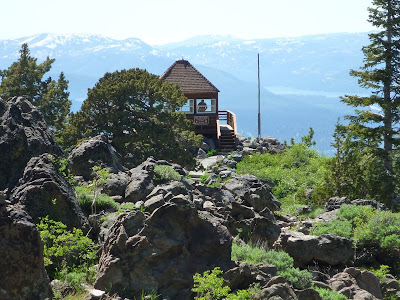Brown's peony (Paeonia brownii) is a flowering plant of western North America, therefore also called western peony. This plant grows in sagebrush desert and pine forests, typically on sandy soils and clay soils [1-3]. The plants shown here were found at a particular semi-shade area along the Tahoe Rim Trail between Brockway Summit and the branch-off to Martis Peak.
 Brown's peony is a leafy plant with bluish-green, divided leaves. The flowers are multicolored. They show a deep purple color, while they are closed. The blossoming flowers have five to six purple-greenish petals, looking like upside-down spoons in the hanging flower of the picture just above. Towards the center, the flowers turn orange and yellow, exposing a cluster of yellow-green miniature bananas, which are thick-walled follicles that hold the seeds [4]. The hermaphrodite peony flowers are pollinated by insects.
Brown's peony is a leafy plant with bluish-green, divided leaves. The flowers are multicolored. They show a deep purple color, while they are closed. The blossoming flowers have five to six purple-greenish petals, looking like upside-down spoons in the hanging flower of the picture just above. Towards the center, the flowers turn orange and yellow, exposing a cluster of yellow-green miniature bananas, which are thick-walled follicles that hold the seeds [4]. The hermaphrodite peony flowers are pollinated by insects.
Northwestern Native Americans made tea from western peony's roots to treat lung ailments [3]. And a powder of the dried and ground root can be used as a dressing on cuts, wounds, burns and sores [1].
References and further reading
[1] Plants for a future: Paeonia brownii - Douglas [www.pfaf.org/user/Plant.aspx?LatinName=Paeonia%20brownii].
[2] Peter Alden and Fred Heath: Field Guide to California. National Audubon Society, Chanticleer Press, 1998; page 161.
[3] Richard Spellenberg: North American Wildflowers. Alfred A. Knopf, New York, 2001.
[4] California Wildflowers: Brown's Peony, Paeonia brownii (Paeoniaceae) [researcharchive.calacademy.org/research/botany/wildflow/wildflowers.asp?w_id=128].
 Brown's peony is a leafy plant with bluish-green, divided leaves. The flowers are multicolored. They show a deep purple color, while they are closed. The blossoming flowers have five to six purple-greenish petals, looking like upside-down spoons in the hanging flower of the picture just above. Towards the center, the flowers turn orange and yellow, exposing a cluster of yellow-green miniature bananas, which are thick-walled follicles that hold the seeds [4]. The hermaphrodite peony flowers are pollinated by insects.
Brown's peony is a leafy plant with bluish-green, divided leaves. The flowers are multicolored. They show a deep purple color, while they are closed. The blossoming flowers have five to six purple-greenish petals, looking like upside-down spoons in the hanging flower of the picture just above. Towards the center, the flowers turn orange and yellow, exposing a cluster of yellow-green miniature bananas, which are thick-walled follicles that hold the seeds [4]. The hermaphrodite peony flowers are pollinated by insects. Northwestern Native Americans made tea from western peony's roots to treat lung ailments [3]. And a powder of the dried and ground root can be used as a dressing on cuts, wounds, burns and sores [1].
References and further reading
[1] Plants for a future: Paeonia brownii - Douglas [www.pfaf.org/user/Plant.aspx?LatinName=Paeonia%20brownii].
[2] Peter Alden and Fred Heath: Field Guide to California. National Audubon Society, Chanticleer Press, 1998; page 161.
[3] Richard Spellenberg: North American Wildflowers. Alfred A. Knopf, New York, 2001.
[4] California Wildflowers: Brown's Peony, Paeonia brownii (Paeoniaceae) [researcharchive.calacademy.org/research/botany/wildflow/wildflowers.asp?w_id=128].























